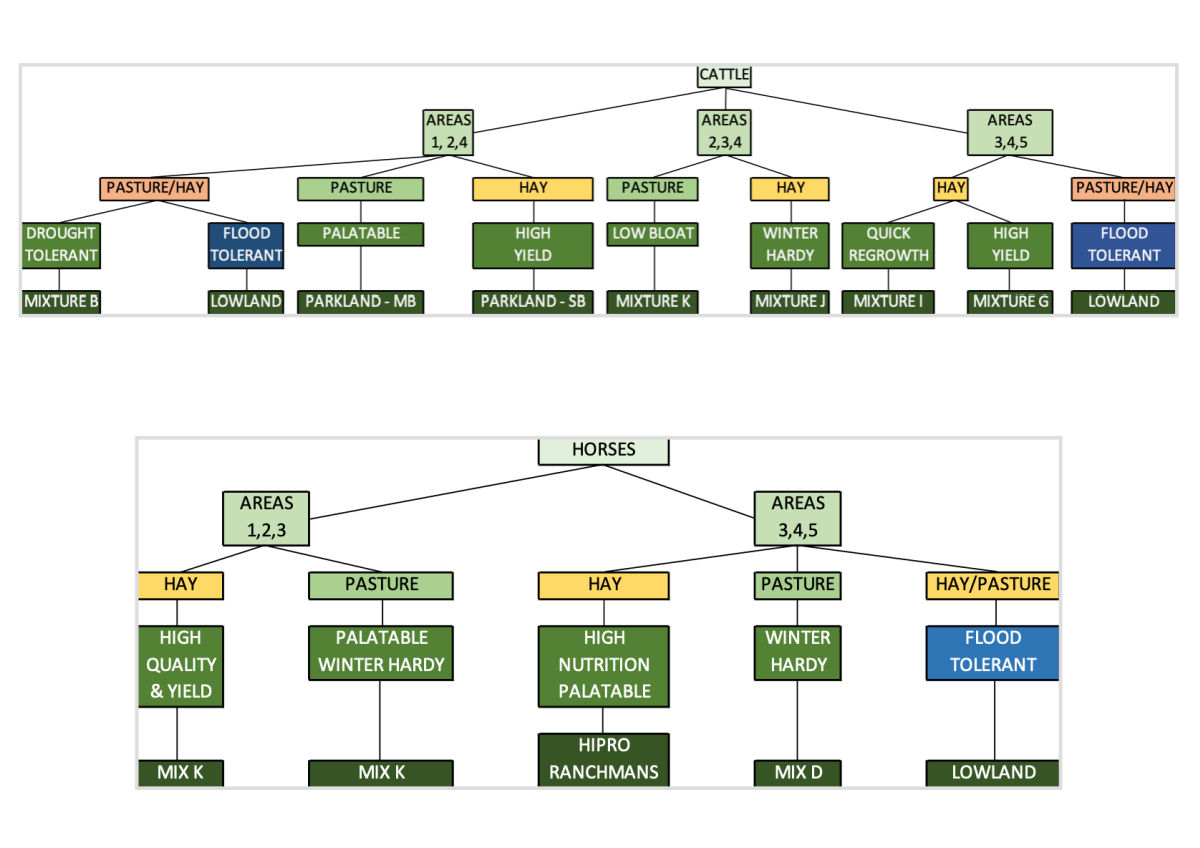Hannas Seeds Forage Selection Chart

CHOOSING THE FORAGE CROP
The importance of choosing the right crop for a particular area or location cannot be too strongly emphasized. The following table indicates soil and climatic conditions to which various forage species are adapted.
LEGUMES
*Rate of Seeding — lbs. per Acre
Alfalfa — 8 to 10 — Prefers moist but well-drained soils. Unequalled as a forage crop.
Alsike — 5 to 6 — Useful where moisture is adequate; on low lands, in areas subject to flooding, and in the cooler, irrigated areas.
Red Clover (Altaswede) — 7 to 8 — Adapted generally to the grey-wooded and black soils.
Sweet Clover — 8 to 12 — Wide adaptation. Especially useful on alkaline and clay soils. Sweet clover weevil may be a problem in some areas.
GROW MIXTURES
Mixtures have several advantages over grasses or legumes sown alone.
1. Legumes increase the feeding value and bulk of the mixture, and since they add nitrogen to the soil they help maintain soil fertility.
2. Grasses fill the soil with needed root fibre. When grown with legumes they furnish hay that is easier to cure, and pastures from which there is less danger of bloating.
3. Mixtures are higher yielding than pure species and remain productive for a longer period of time. They also provide better seasonal distribution of herbage.
4. They are adapted to a much wider range of soil and moisture conditions than either a single grass or a single legume species.
*Prices subject to change without notice* *All legumes are pre-inoculated with Nitragin Gold*
GRASSES
Brome — 10 to 12 — Adapted to wide range of moisture conditions. Makes good growth throughout the summer.
Creeping Red Fescue — 6 to 8 — A useful grass except where moisture is limited. Good pasture from spring to late fall. Extensive root system.
Crested Wheat — 6 to 10 — Thrives on the dry, open plains, and on sandy soils in other areas. Makes early spring and late fall growth. Extensive root system.
Timothy — 5 to 6 — Likes rich, moist soils and cool temperatures. Stands are short lived.
Slender Wheatgrass — 10 to 12 — Useful for alkali salty and spring flooded land. Fair hay and pasture. Stands are short lived.
Reed Canary Grass — 6 to 8 — Very tolerant of flooding. Good pasture, coarse hay. Develops a tough sod.
Orchard Grass — 10 to 12 — An excellent grass under irrigation. May winter kill farther north.
Tall Wheatgrass — 10 to 12 — Useful for wet, alkaline soils. Makes fair hay or pasture.
* In very dry areas, not over half the maximum rates given above should be used, and rows should be twice as far apart, e.g., crested wheatgrass should be seeded at 3 to 5 pounds per acre in rows 12″ to 14″ apart.
Alfalfas, Clovers and Grasses
Receive a 10% Discount
on early bookings of forage seed
Fill out the form to get your code.
